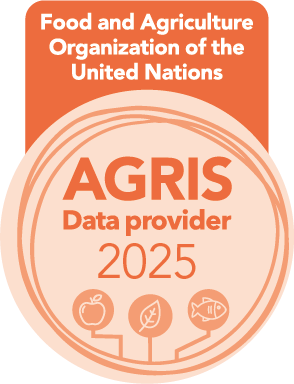Tech-Driven Evolution of Trait Performance in Oilseed Crops: A Contemporary Perspective
Advancements in Gene Editing Techniques
DOI:
https://doi.org/10.54393/df.v6i1.120Keywords:
Clusture Regularly Interspace Short Palindromic Repeats (CRISPR), Oilseed Crops, Gene Editing, Traditional Breeding, Vector Construction, Agrobacterium Mediated Plant TransformationAbstract
Targeted nucleases are resilient genomic tools that accurately modify the intended genome of living cells, regulating functioning genes with great precision. Gene editing techniques (GETs), especially CRISPR-cas9, are utilized for genetic manipulation with greater efficacy, versatility, cost-efficiency, and capacity for high-throughput applications in the fields of medicine, biology, agriculture, and biotechnology. It has been successfully used for the treatment of genetic diseases in humans and oilseed crop improvements such as disease resistance, reducing seed shattering, herbicide resistance, and improving oil quality and quantity. The purpose of this review is to summarize the potential application of GETs to bring improvements to oilseed crops. In the current study, three different methodologies to incorporate desire traits in oilseed crops are discussed, mainly for the needs of farmers and consumer demands. The methodologies included conventional plant breeding (CPB), mutagenesis plant breeding (MPB), and the advanced gene editing tool CRISPR-cas9. Ongoing inventions in the agriculture field and in the last decade (ten years) are focused. Results: Mechanistic representation in detail was given for editing plant genomes using various strategies such as PEG-mediated, biolistic, and agro-bacterium-mediated plant transformation. The modification of agricultural crops was required to increase the nation's economic condition. In the future, to overcome food security issues, researchers from multidisciplinary fields can plan their work in oilseed crops or relevant disciplines for the betterment of humanity.
References
Sampson TR, Saroj SD, Llewellyn AC, Tzeng YL, Weiss DS. A CRISPR/Cas System Mediates Bacterial Innate Immune Evasion and Virulence. Nature. 2013; 497(7448): 254-257. doi: 10.1038/nature12048.
Sorek R, Lawrence CM, Wiedenheft B. CRISPR-Mediated Adaptive Immune Systems in Bacteria and Archaea. Annual Review of Biochemistry. 2013; 82: 237-266. doi: 10.1146/annurev-biochem-072911-172315.
Sternberg SH, Redding S, Jinek M, Greene EC, Doudna JA. DNA Interrogation by the CRISPR RNA-Guided Endonuclease Cas9. Biophysical Journal. 2014; 106(2): 695a. doi: 10.1016/j.bpj.2013.11.3848.
Burstein D, Harrington LB, Strutt SC, Probst AJ, Anantharaman K, Thomas BC, et al. New CRISPR-Cas Systems from Uncultivated Microbes. Nature. 2017; 542(7640): 237-241. doi: 10.1038/nature21059.
Puchta H, Jiang J, Wang K, Zhao Y. Updates on Gene Editing and its Applications. Plant Physiology. 2022; 188(4): 1725-1730. doi: 10.1093/plphys/kiac032.
Wang ZP, Xing HL, Dong L, Zhang HY, Han CY, Wang XC, et al. Egg Cell-Specific Promoter-Controlled CRISPR/Cas9 Efficiently Generates Homozygous Mutants for Multiple Target Genes in Arabidopsis in A Single Generation. Genome Biology. 2015; 16: 1-12. doi: 10.1186/s13059-015-0715-0.
Shah SA, Erdmann S, Mojica FJ, Garrett RA. Protospacer Recognition Motifs: Mixed Identities and Functional Diversity. RNA Biology. 2013; 10(5): 891-899. doi: 10.4161/rna.23764.
Leenay RT, Maksimchuk KR, Slotkowski RA, Agrawal RN, Gomaa AA, Briner AE, et al. Identifying and Visualizing Functional PAM Diversity Across CRISPR-Cas Systems. Molecular Cell. 2016; 62(1): 137-147. doi: 10.1016/j.molcel.2016.02.031.
Li S and Xia L. Precise Gene Replacement in Plants Through CRISPR/Cas Genome Editing Technology: Status and Future Perspectives. Abiotechnology. 2020; 1: 58-73. doi: 10.1007/s42994-019-00009-7.
Vu TV, Sivankalyani V, Kim EJ, Doan DTH, Tran MT, Kim J, et al. Highly Efficient Homology‐Directed Repair Using CRISPR/Cpf1‐Geminiviral Replicon in Tomato. Plant Biotechnology Journal. 2020; 18(10): 2133-2143. doi: 10.1111/pbi.13373.
Chalhoub B, Denoeud F, Liu S, Parkin IA, Tang H, Wang X, et al. Early Allopolyploid Evolution in the Post-Neolithic Brassica napus Oilseed Genome. Science. 2014; 345(6199): 950-953. doi: 10.1126/science.1253435.
Wells R, Trick M, Soumpourou E, Clissold L, Morgan C, Werner P, et al. The Control of Seed Oil Polyunsaturate Content in The Polyploid Crop Species Brassica Napus. Molecular Breeding. 2014; 33: 349-362. doi: 10.1007/s11032-013-9954-5.
Menz J, Modrzejewski D, Hartung F, Wilhelm R, Sprink T. Genome Edited Crops Touch the Market: A View on The Global Development and Regulatory Environment. Frontiers in Plant Science. 2020; 11: 586027. doi: 10.3389/fpls.2020.586027.
Bao A, Zhang C, Huang Y, Chen H, Zhou X, Cao D. Genome Editing Technology and Application in Soybean Improvement. Oil Crop Science. 2020; 5(1): 31-40. doi: 10.1016/j.ocsci.2020.03.001.
He J, Zhang K, Tang M, Zhou W, Chen L, Chen Z, et al. CRISPR-Based Genome Editing Technology and Its Applications in Oil Crops. Oil Crop Science. 2021; 6(3): 105-113. doi: 10.1016/j.ocsci.2021.07.002.
Gaj T, Gersbach CA, Barbas CF. ZFN, TALEN, and CRISPR/Cas-Based Methods for Genome Engineering. Trends in Biotechnology. 2013; 31(7): 397-405. doi: 10.1016/j.tibtech.2013.04.004.
Jiang W, Bikard D, Cox D, Zhang F, Marraffini LA. CRISPR-Assisted Editing of Bacterial Genomes. Nature Biotechnology. 2013; 31(3): 233. doi: 10.1038/nbt.2508.
Mali P, Yang L, Esvelt KM, Aach J, Guell M, DiCarlo JE, et al. RNA-Guided Human Genome Engineering Via Cas9. Science. 2013; 339(6121): 823-826. doi: 10.1126/science.1232033.
Park SH, Lee CM, Dever DP, Davis TH, Camarena J, Srifa W, et al. Highly Efficient Editing of the Beta-Globin Gene in Patient-Derived Hematopoietic Stem and Progenitor Cells to Treat Sickle Cell Disease. Nucleic Acids Research. 2019; 47: 7955-7972. doi: 10.1093/nar/gkz475.
Reimer J, Knöß S, Labuhn M, Charpentier EM, Göhring G, Schlegelberger B, et al. CRISPR-Cas9-Induced t (11; 19)/MLL-ENL Translocations Initiate Leukemia in Human Hematopoietic Progenitor Cells In Vivo. Haematologica. 2017; 102(9): 1558. doi: 10.3324/haematol.2017.164046.
Chen K, Wang Y, Zhang R, Zhang H, Gao C. CRISPR/Cas Genome Editing and Precision Plant Breeding in Agriculture. Annual Review of Plant Biology. 2019; 70: 667-697. doi: 10.1146/annurev-arplant-050718-100049.
Bassett AR and Liu JL. CRISPR/Cas9 and Genome Editing in Drosophila. Journal of Genetics and Genomics. 2014; 41(1): 7-19. doi: 10.1016/j.jgg.2013.12.004.
Ran FA, Hsu PD, Wright J, Agarwala V, Scott DA, Zhang F. Genome Engineering Using the CRISPR-Cas9 System. Nature Protocols. 2013; 8(11): 2281-2308. doi: 10.1038/nprot.2013.143.
Fu YW, Dai XY, Wang WT, Yang ZX, Zhao JJ, Zhang JP, et al. Dynamics and Competition of CRISPR-Cas9 Ribonucleoproteins and AAV Donor-Mediated NHEJ, MMEJ and HDR Editing. Nucleic Acids Research. 2021; 49(2): 969-985. doi: 10.1093/nar/gkaa1251.
Shi J, Lang C, Wu X, Liu R, Zheng T, Zhang D, et al. RNAi Knockdown of Fatty Acid Elongase1 Alters Fatty Acid Composition in Brassica napus. Biochemical and Biophysical Research Communications. 2015; 466(3): 518-522. doi: 10.1016/j.bbrc.2015.09.062.
Villanueva-Mejia D and Alvarez JC. Genetic Improvement of Oilseed Crops Using Modern Biotechnology. Advances in Seed Biology. 2017; 295-317. doi: 10.5772/intechopen.70743.
Ashkani S, Rafii MY, Shabanimofrad M, Miah G, Sahebi M, Azizi P,et al. Molecular Breeding Strategy and Challenges Towards Improvement of Blast Disease Resistance in Rice Crop. Frontiers in Plant Science. 2015; 6: 886. doi: 10.3389/fpls.2015.00886.
Xu Q, Zhao M, Wu K, Fu X, Liu Q. Emerging Insights into Heterotrimeric G Protein Signaling in Plants. Journal of Genetics and Genomics. 2016; 43(8): 495-502. doi: 10.1016/j.jgg.2016.06.004.
Scheben A, Wolter F, Batley J, Puchta H, Edwards D. Towards CRISPR/Cas Crops-Bringing Together Genomics and Genome Editing. New Phytologist. 2017; 216(3): 682-698. doi: 10.1111/nph.14702.
Acquaah G. Principles of Plant Genetics and Breeding. John Wiley & Sons. 2009.
Das D, Singha DL, Paswan RR, Chowdhury N, Sharma M, Reddy PS, et al. Recent Advancements in CRISPR/Cas Technology for Accelerated Crop Improvement. Planta. 2022; 255(5):109. doi: 10.1007/s00425-022-03894-3.
Jeon D, Kang Y, Lee S, Choi S, Sung Y, Lee TH, et al. Digitalizing Breeding in Plants: A New Trend of Next-Generation Breeding Based on Genomic Prediction. Frontiers in Plant Science. 2023; 14: 1092584. doi: 10.3389/fpls.2023.1092584.
Ichida H, Morita R, Shirakawa Y, Hayashi Y, Abe T. Targeted Exome Sequencing of Unselected Heavy-Ion Beam-Irradiated Populations Reveals Less-Biased Mutation Characteristics in the Rice Genome. The Plant Journal. 2019; 98(2): 301-314. doi: 10.1111/tpj.14213.
Yang G, Luo W, Zhang J, Yan X, Du Y, Zhou L, et al. Genome-Wide Comparisons of Mutations Induced by Carbon-Ion Beam and Gamma-Rays Irradiation in Rice via Resequencing Multiple Mutants. Frontiers in Plant Science. 2019; 10: 1514. doi: 10.3389/fpls.2019.01514.
Zheng Y, Li S, Huang J, Fu H, Zhou L, Furusawa Y, et al. Mutagenic Effect of Three Ion Beams on Rice and Identification of Heritable Mutations by Whole Genome Sequencing. Plants. 2020; 9(5): 551. doi: 10.3390/plants9050551.
Ali E and Zhang K. CRISPR-Mediated Technology for Seed Oil Improvement in Rapeseed: Challenges and Future Perspectives. Frontiers in Plant Science. 2023; 14: 1086847. doi: 10.3389/fpls.2023.1086847.
Braatz J, Harloff HJ, Mascher M, Stein N, Himmelbach A, Jung C. CRISPR-Cas9 Targeted Mutagenesis Leads to Simultaneous Modification of Different Homoeologous Gene Copies in Polyploid Oilseed Rape (Brassica Napus). Plant Physiology. 2017; 174(2): 935-942. doi: 10.1104/pp.17.00426.
Tan Z, Xie Z, Dai L, Zhang Y, Zhao H, Tang S, et al. Genome‐and Transcriptome‐Wide Association Studies Reveal the Genetic Basis and the Breeding History of Seed Glucosinolate Content in Brassica Napus. Plant Biotechnology Journal. 2022; 20(1): 211-225. doi: 10.1111/pbi.13707.
Yan G, Yu P, Tian X, Guo L, Tu J, Shen J, et al. DELLA Proteins BnaA6. RGA and BnaC7. RGA Negatively Regulate Fatty Acid Biosynthesis by Interacting with BnaLEC1s in Brassica Napus. Plant Biotechnology Journal. 2021; 19(10): 2011-2026. doi: 10.1111/pbi.13628.
Altpeter F, Springer NM, Bartley LE, Blechl AE, Brutnell TP, Citovsky V, et al. Advancing Crop Transformation in the Era of Genome Editing. The Plant Cell. 2016; 28(7): 1510-1520. doi: 10.1105/tpc.16.00196.
Komor AC, Kim YB, Packer MS, Zuris JA, Liu DR. Programmable Editing of a Target Base in Genomic DNA Without Double-Stranded DNA Cleavage. Nature. 2016; 533(7603): 420-424. doi: 10.1038/nature17946.
Gaudelli NM, Komor AC, Rees HA, Packer MS, Badran AH, Bryson DI. Programmable Base Editing of A•T to G•C in Genomic DNA Without DNA Cleavage. Nature. 2017; 551(7681): 464-471. doi: 10.1038/nature24644.
Wu S, Zhu H, Liu J, Yang Q, Shao X, Bi F, et al. Establishment of a PEG-Mediated Protoplast Transformation System Based on DNA and CRISPR/Cas9 Ribonucleoprotein Complexes for Banana. BMC Plant Biology. 2020; 20: 1-10. doi: 10.1186/s12870-020-02609-8.
Li Z, Liu ZB, Xing A, Moon BP, Koellhoffer JP, Huang L, et al. Cas9-Guide RNA Directed Genome Editing in Soybean. Plant Physiology. 2015; 169(2): 960-970. doi: 10.1104/pp.15.00783.
Liang Z, Chen K, Gao C. Biolistic Delivery of CRISPR/Cas9 with Ribonucleoprotein Complex in Wheat. Plant Genome Editing with CRISPR Systems: Methods and Protocols. 2019; 327-335. doi: 10.1007/978-1-4939-8991-1_24.
Baltes NJ, Gil-Humanes J, Voytas DF. Genome Engineering and Agriculture: Opportunities and Challenges. Progress in Molecular Biology and Translational Science. 2017; 149: 1-26. doi: 10.1016/bs.pmbts.2017.03.011.
Miller K, Eggenberger AL, Lee K, Liu F, Kang M, Drent M. An Improved Biolistic Delivery and Analysis Method for Evaluation of DNA and CRISPR-Cas Delivery Efficacy in Plant Tissue. Scientific Reports. 2021; 11(1):7695. doi: 10.1038/s41598-021-86549-9.
Murovec J, Guček K, Bohanec B, Avbelj M, Jerala R. DNA-Free Genome Editing of Brassica Oleracea and B. Rapa Protoplasts Using CRISPR-Cas9 Ribonucleoprotein Complexes. Frontiers in Plant Science. 2018; 9: 1594. doi: 10.3389/fpls.2018.01594.
Zhang Y, Iaffaldano B, Qi Y. CRISPR Ribonucleoprotein-Mediated Genetic Engineering in Plants. Plant Communications. 2021; 2(2). doi: 10.1016/j.xplc.2021.100168.
Mishra R, Joshi RK, Zhao K. Base Editing in Crops: Current Advances, Limitations and Future Implications. Plant Biotechnology Journal. 2020; 18(1): 20-31. doi: 10.1111/pbi.13225
Eid A, Alshareef S, Mahfouz MM. CRISPR Base Editors: Genome Editing Without Double-Stranded Breaks. Biochemical Journal. 2018; 475(11): 1955-1964. doi: 10.1042/BCJ20170793.
Cheng H, Hao M, Ding B, Mei D, Wang W, Wang H, et al. Base Editing with High Efficiency in Allotetraploid Oilseed Rape by A3A‐PBE System. Plant Biotechnology Journal. 2021; 19(1): 87-97. doi: 10.1111/pbi.13444.
Butt H, Rao GS, Sedeek K, Aman R, Kamel R, Mahfouz M. Engineering Herbicide Resistance via Prime Editing in Rice. Plant Biotechnology Journal. 2020; 18(12): 2370. doi: 10.1111/pbi.13399.
Hirsch F, Iphofen R, Koporc Z. Ethics Assessment in Research Proposals Adopting CRISPR Technology. Biochemia Medica. 2019; 29(2): 206-213. doi: 10.11613/BM.2019.020202.
Cathomen T, Schüle S, Schüßler-Lenz M, Abou-El-Enein M. The Human Genome Editing Race: Loosening Regulatory Standards for Commercial Advantage? Trends in Biotechnology. 2019; 37(2): 120-123. doi: 10.1016/j.tibtech.2018.06.005.
Greene M and Master Z. Ethical Issues of Using CRISPR Technologies for Research on Military Enhancement. Journal of Bioethical Inquiry. 2018; 15(3): 327-335. doi: 10.1007/s11673-018-9865-6.
Hundleby PA and Harwood WA. Impacts of the EU GMO Regulatory Framework for Plant Genome Editing. Food and Energy Security. 2019; 8(2): e00161. doi: 10.1002/fes3.161.
Shinwari ZK, Tanveer F, Khalil AT. Ethical Issues Regarding CRISPR Mediated Genome Editing. Current Issues in Molecular Biology. 2018; 26(1): 103-110. doi: 10.21775/cimb.026.103.
Downloads
Published
How to Cite
Issue
Section
License
Copyright (c) 2025 DIET FACTOR (Journal of Nutritional and Food Sciences)

This work is licensed under a Creative Commons Attribution 4.0 International License.
This is an open-access journal and all the published articles / items are distributed under the terms of the Creative Commons Attribution License, which permits unrestricted use, distribution, and reproduction in any medium, provided the original author and source are credited. For comments












